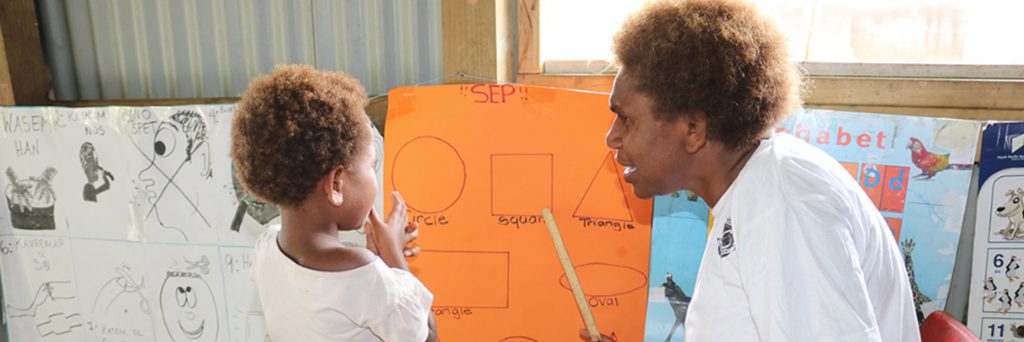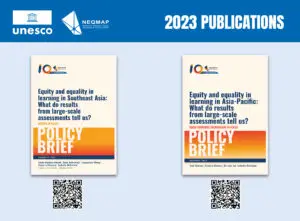
Olivette Nakou of Loukatai Base Kindy in Vanuatu revises basic shapes with one of her students. Enrolment into an early childhood education programme was found by the PILNA 2018 as a positive influence on student performance in literacy and numeracy. Photo by Irene Manarae
Are the Pacific region’s Year 4 and Year 6 students making strong progress in learning the basic literacy and numeracy skills? What aspects of these foundational skills are the most challenging for them to learn? What specific concepts and skills should teachers devote more attention to? Where should governments boost support for their elementary teachers to become more effective in their work?
Some of the answers to these kinds of questions are emerging from the Pacific Islands Literacy and Numeracy Assessment (PILNA) research findings. The research provides the best snapshot of whether the region’s students at Grades Four and Six, or the equivalent, are achieving the learning goals for their respective levels. PILNA also explores beyond their achievement levels by identifying the main areas of weakness and the various reasons that may have led to the errors made.
Like in any part of the world, a strong grasp of literacy and numeracy skills is needed for Pacific Island students to transform their lives through education. These skills comprise of fundamental skills like reading, comprehension, writing, grammar, numbers and operations, probability and critical thinking. This is why support for students to master these fundamentals, especially at the early levels of formal education, is key.
PILNA is administered by the Pacific Community’s education division, better known as the Educational Quality and Assessment Programme or EQAP. The regional study is administered with the assistance of its partners and the 15 PILNA countries involved. This is only one of several targeted initiatives that EQAP undertakes to help improve children’s basic literacy and numeracy skills. Much of this effort is made possible through the generous support of the Australian and New Zealand governments.
Findings of the last PILNA cycle (2016-2018) were released earlier this year, with the country-specific results released solely to the owners of the information – the 15 PILNA countries. In-country presentations and workshops were conducted to better understand the findings at the various levels of education; from policy-makers to school leaders and teachers. The findings are presented in a regional report that accounts for the combined results from all 15 countries. There is also a PILNA 2018 Small Islands States report that reflects on the research findings from the SIS countries. A technical report of the study is also available, particularly for the benefit of statisticians, researchers and policy-makers. The PILNA 2018 round marks a milestone for the region because for the first time, the Pacific region has three data points (2012, 2015 and 2018) to help its education systems and development partners to evaluate how well efforts to improve literacy and numeracy are progressing. The research in PILNA 2018 involved more than 40,000 students in 900-plus schools. PILNA was administered in 10 different languages and it relied on the efforts of more than 2000 teachers, head teachers and ministry officials across the 15 countries. The extensive effort is a stellar example of regional cooperation and sharing of knowledge for a common good.
Many positive findings were gleaned from PILNA 2018. It established that, compared to the previous cycles, a greater share of students have reached the higher levels of literacy, and the number of students who were not meeting the minimum expected standards in literacy has decreased. Similarly, significant improvement was noted in Year 4 numeracy from PILNA 2012. There was also a greater portion of students who reached the highest levels in numeracy. The data and strand chance was the numeracy area that proved the most challenging for students. This finding corresponds with the fact that a significant proportion of teachers reported lower confidence levels in teaching data and chance. Fractions and geometry were the other areas most singled out.
There were also findings of notable concern. At the Year 6 level, almost four in every 10 students (37 per cent) are failing to learn basic literacy skills, and 17 per cent are failing to achieve basic numeracy skills. And of the lowest performing students, 30 per cent were unable to engage with even the simplest readings that were part of the tested items/questions.
The learning disparity between girls and boys has also increased. For Year 6, girls registered a mean score 26 points higher than boys in reading. For writing, girls posted a mean score 35 points ahead of boys. This is a significant gap when one considers that 50 points is equivalent to two years in school. The results were similar in this regard for Year 4.
The other significant revelation was the lack of critical thinking skills. Reading comprehension questions and word problems in numeracy suggest that students struggled to interpret and apply the appropriate learnings. For Year 6, when the item/question required interpretation or reasoning, often only about 30 per cent were successful. Students performed less well on items that required them to ‘read between the lines’ and items that required critical thinking. On the items that required interpretation or critical analysis, more than half of the students were unable to provide the expected response. This was especially the case for critical analysis questions; many failed to provide a reason or explanation for a response.
Data gleaned from the contextual questionnaires suggest that the lack of resources in the classroom and in the homes could be significant factors for the challenges to learning. This was the first cycle in which contextual data was gathered through questionnaires to students, teachers and school leaders. From the quality of support for students at home and home resources, to community support for schools and teacher experience, the PILNA contextual questions have given education stakeholders a more holistic picture of the students’ realities.
The education ministries of the 15 PILNA countries are engaging with the massive data sets at their disposal. Following in-country presentations and a data workshop that equipped country reps with tools to assist in mining their data, education systems will need time to deeply analyse and extract the relevant data that will help them refine their intervention strategies and learning systems. It will be a continuous process of investigation and analysis; with new questions surfacing as the data is being extrapolated.
All in all, the Pacific’s education systems are in a stronger position today to make better decisions because of the quality of credible data that PILNA has amassed. The PILNA data, which complements the national assessments of the various countries, reflects the commitment of these 15 Pacific Island governments, EQAP’s technical partner – the Australian Centre for Education Research (ACER), New Zealand Ministry of Foreign Affairs and Trade (MFAT), Australia’s Department of Foreign Affairs and Trade (DFAT), and the education stakeholders in the region. It is an impressive effort that recognises the role of large-scale assessments; a much-needed gauge to help ensure the quality of education delivered in our classrooms. This investment acknowledges the fact that while the enrolment of all school-aged children is very important, it does not equate to learning. Education must be of quality. It is the best way to ensure our students realise their full potential. The region cannot afford to fail its children, its most important asset for a prosperous and sustainable future.

Vanuatu’s Norah Wells contributes to the discussion at the PILNA 2018 workshop. The workshop was one of several initiatives to help Pacific education systems to better leverage the PILNA data. Beside Wells is Louise Ockwell, a research fellow at ACER. Photo by Irene Manarae
Click on this link to download the PILNA 2018 Regional Report.
Written by: Irene Manarae






